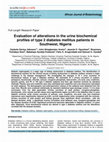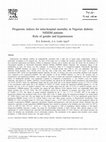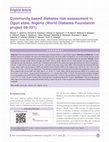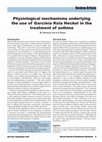Papers by Babatope Kolawole

Nigerian quarterly journal of hospital medicine
C-reactive protein (CRP) is an acute phase reactant produced in the liver in response to tissue i... more C-reactive protein (CRP) is an acute phase reactant produced in the liver in response to tissue injury or systemic inflammation, its release is stimulated by cytokines (interleukin-6 and tumour necrosis factor-alpha). Elevated CRP levels have been linked to an increased risk of later development of diabetes mellitus and systemic hypertension. Baseline level of C-reactive protein in apparently healthy men and women predict long-term risk of a first myocardial infarction. The study design was cross-sectional conducted among apparently healthy adult relative of patients and hospital staff of the Obafemi Awolowo University Teaching Hospitals complex (OAUTHC) Ile Ife, Osun State south western Nigeria. Serum lipids and fasting blood glucose were measured, while C-reactive protein measurement was based on the principle of solid phase enzyme-linked immunosorbent assay (ELISA). Atotal of 50 apparently healthy consecutive adult subjects were recruited into the study comprising 19 male and 31 ...

World Journal of Diabetes, 2021
Peripheral arterial disease (PAD) refers to partial or complete occlusion of the peripheral vesse... more Peripheral arterial disease (PAD) refers to partial or complete occlusion of the peripheral vessels of the upper and lower limbs. It usually occurs as part of systemic atherosclerosis in the coronary and cerebral arteries. The prevalence of PAD is expected to continue to increase in the foreseeable future owing to the rise in the occurrence of its major risk factors. Nonhealing ulcers, limb amputation and physical disability are some of its major complications. Diabetes mellitus (DM) remains a major risk for PAD, with DM patients having more than two-fold increased prevalence of PAD compared with the general population. The clinical presentation in people with DM also differs slightly from that in the general population. In addition, PAD in DM may lead to diabetic foot ulcers (DFUs), which precipitate hyperglycaemic emergencies and result in increased hospital admissions, reduced quality of life, and mortality. Despite the epidemiological and clinical importance of PAD, it remains largely under diagnosed and hence undertreated, possibly because it is largely asymptomatic. Emphasis has been placed on neuropathy as a cause of DFUs, however PAD is equally important. This review examines the epidemiology, pathophysiology and diagnosis of lower limb PAD in people with diabetes and relates these to the general population. It also highlights recent innovations in the management of PAD.

International Journal of Healthcare Information Systems and Informatics, 2021
Engineering smart software that can monitor, predict, and control blood glucose is critical to im... more Engineering smart software that can monitor, predict, and control blood glucose is critical to improving patients' quality of treatments with type 1 Diabetic Mellitus (T1DM). However, ensuring a reasonable glycemic level in diabetic patients is quite challenging, as many methods do not adequately capture the complexities involved in glycemic control. This problem introduces a new level of complexity and uncertainty to the patient's psychological state, thereby making this problem nonlinear and unobservable. In this paper, we formulated a mathematical model using carbohydrate counting, insulin requirements, and the Harris-Benedict energy equations to establish the framework for predicting and controlling blood glucose level regulation in T1DM. We implemented the framework and evaluated its performance using root mean square error (RMSE) and mean absolute error (MAE) on a case study. Our framework had less error rate in terms of RMSE and MAE, which indicates a better fit with ...

AFRICAN JOURNAL OF BIOTECHNOLOGY
Diabetic nephropathy is a major sign of kidney dysfunction in diabetes mellitus. The identificati... more Diabetic nephropathy is a major sign of kidney dysfunction in diabetes mellitus. The identification of biochemical markers for the clinical course of kidney dysfunction in diabetes mellitus remains a major challenge in the disease management. We investigated the changes in 24 h urine excretion of biochemical indices of type 2 diabetes mellitus. We estimated 24 h urinary excretion of sodium, potassium, bicarbonate, chloride, calcium, inorganic-phosphate, total protein, uric-acid, urea, creatinine, specific gravity, and Ph in 150 type 2 diabetic subjects and their age matched controls by standard methods. Plasma urea and creatinine were also estimated and creatinine and urea clearances calculated for both subjects. The demographic and anthropometric indices of the subjects were obtained from the case files. Results were analyzed statistically by standard statistical spss package version 11.0 to draw conclusion from the data generated. Urinary excretion of total protein, inorganic-phosphate, bicarbonate, urine volume and pH values were significantly higher (p<0.05) in the diabetics than in none diabetic controls, while urinary excretion of calcium, urea, creatinine, uric-acid, urea and creatinine clearances were significantly reduced (p<0.001, p<0.05 respectively) when compared with the controls. Urinary excretion of total protein and fasting glucose have significant direct correlation with the disease duration, while a significant inverse correlation exist between urea, inorganic-phosphate and the disease duration (P<0.05). Significant proteinuria becomes detectable in diabetes mellitus 1-5 years after diagnosis. Urine biochemical indices are altered in type 2 diabetes mellitus and the alterations correlate with the disease duration.

Journal of Medical Ultrasound, 2019
Diabetes mellitus (DM) is an endocrine disease with a prevalence of 5.1% worldwide, [1] and Niger... more Diabetes mellitus (DM) is an endocrine disease with a prevalence of 5.1% worldwide, [1] and Nigeria has the highest number of people living with DM in Africa. [2-4] Diabetic neuropathy occurs in 50% of individuals with long-standing DM, manifesting as autonomic neuropathy. [5] Plantar ulcers characterized by the triad of neuropathy, infection, and ischemia [6] are also a known complication of DM. The global incidence of DM foot is estimated to be 15%, and 12%-24% of individuals with diabetic foot ulcers require amputation. [7] Amputation risks in diabetic patients are about 15-40 times higher than in nondiabetic patients, [8,9] and the risk of lower extremity amputation increases by a factor of 8 once an ulcer develops. [10-14] DM predisposes to plantar fasciopathy, a disorder characterized by thickened plantar fascia (PF), and loss of the normal organized PF architecture. [15] PF is one of those tissues that may change their physiology and biomechanical function in the presence of chronic hyperglycemia. Studies by Sharkey et al. [16] revealed that the PF actively contributes to influence the pressure acting on the metatarsal heads. The pathophysiology defining affectation of the PF and Achilles tendon (AT) in DM can be summarized as running the following course: sustained hyperglycemia promotes increased glycosylation of proteins, resulting in accumulation of "advanced glycosylation end products" in patient's soft tissue and in thickening and vascularization of the AT and PF. The increased AT thickness (ATT) and PF thickness (PFT) in DM have been considered an expression of soft-tissue damages. [17] The superficial anatomical positions of the AT and PF allow high-resolution imaging with ultrasonography.

International Ophthalmology, 2015
Diabetes and blindness are important health issues globally; we determined the prevalence of blin... more Diabetes and blindness are important health issues globally; we determined the prevalence of blindness, diabetic retinopathy, and other eye diseases in Nigerian-type 2 diabetics. A prospective, cross-sectional study was conducted on consenting type 2 diabetic patients who had scheduled comprehensive eye examination including dilated funduscopy with +78DS. Visual status was graded using the WHO criteria. Approval from Institutional Ethics Committee was obtained. Primary outcome measures were the prevalence and causes of blindness as well as prevalence of diabetic retinopathy. Secondary outcome measures were the presence of other eye diseases. Data were analyzed using SPSS version 13. Two hundred and sixty-six eyes of 133 type 2 diabetic patients aged 22-89 years were studied; 69 (51.9 %) were males while 64 (48.1 %) were females. Five (3.8 %) patients were blind while 27 (20.3 %) were visually impaired. Cataract was the leading cause of blindness (60 %) and visual impairment was found in 59.3 %. Diabetic retinopathy was present in 37 (27.8 %) diabetic patients of which 5 (3.8 %) were proliferative. Diabetic macular edema was present in 31 (23.3 %) patients. Severe visual impairment and blindness were commoner in those with diabetic retinopathy. Refractive error 67 (25.2 %), cataract 63 (23.7 %), and chronic glaucoma 44 (16.5 %) were the most prevalent non-diabetic retinopathy eye diseases. High prevalence of blindness, diabetic retinopathy, and other diseases are seen in type 2 diabetics. Health education, early diagnosis as well as treatment of diabetic retinopathy and other diseases will largely alleviate these ocular morbidities.

Nigerian journal of medicine : journal of the National Association of Resident Doctors of Nigeria
Thyroid hormone has effects on both the peripheral circulation and the myocardium. These include ... more Thyroid hormone has effects on both the peripheral circulation and the myocardium. These include a decline in the systemic vascular resistance and an increase in cardiac output and cardiac contractility. Exposure to excess thyroid hormone, as occurs in thyrotoxicosis, can not only aggravate preexisting cardiac disease but also by itself lead to cardiac disease. More patients are being reported with thyrotoxicosis in Nigeria while the facilities for diagnosis and treatment are improving and becoming more available. There should therefore be a greater awareness of the cardiac problems associated with thyrotoxicosis, especially atrial fibrillation and cardiac failure. Initial management of heart disease in thyrotoxicosis should focus on the prompt alleviation of hyperthyroidism combined with judicious use of diuretics, digoxin and beta-blockers.
Endocrine Abstracts, 2013

Journal of Diabetes and its Complications, 2000
Hypertension and diabetes mellitus are independently associated with a high rate of target organ ... more Hypertension and diabetes mellitus are independently associated with a high rate of target organ complications, which is particularly accentuated in the Negroid race. The aims of this study were to evaluate the mortality associated with diabetes mellitus and concurrent hypertension and diabetes mellitus in indigenous Africans, and to identify and assess the factors that are predictive of intra-hospital mortality in Non-Insulin Dependent Diabetes Mellitus (NIDDM) diabetic Nigerians. The subsequent impact of the modification of these risk factors was also evaluated. A prospective study of 51 hypertensive-diabetic (Non-Insulin Dependent Diabetics, NIDDM) Nigerians (32 males, 19 females) over a 15-month period, from 1996 to 1997 was undertaken. The mean admission blood pressures were 170/102 35/22 mm Hg, with a body mass index (BMI) of 25.4 10.2 kg/m 2. A total of 54 normotensive (BP < 130/85 mm Hg)-NIDDM diabetic Nigerians (30 men, 24 women), who were concurrently admitted in the hospital, were compared to the hypetensive-NIDDM. The total mortality of all the NIDDM diabetics, as well as the mortality rates in normotensives and hypertensive-diabetics, were computed. The causes of death and associated complications were noted. Predictive indices of intrahospital mortality were statistically evaluated by comparison of proportions, c 2 test, Fischer's exact test, logistic regression, and analysis of variance (ANOVA). Overall mortality rate among all the diabetics (both normotensive and hypertensive) was 26.6% (28/105), which was significantly higher than the crude death rate on the Internal Medicine service of 17.8% (P = 0.006) or the non-obstetric crude death rate in the hospital of 10.96% (P = 0.001) Among the hypertensive-NIDDM patients (n = 51) the mortality rate was 31.4% (16 deaths/51 patients). This was slightly higher than the value of 22.2% (12 deaths/54 patients) seen in normotensive-NIDDM patients. The mortality rate among the male diabetics (23/63 patients) 46.6% was significantly higher than female mortality rate of 11.6% (5/43). The 95% Confidence interval for the difference in mortality rates being 16.9% to 53.3% (P < 0.0001, z = 3.57). The impact of gender remained significant by the c 2 test, c 2 = 7.17, P = 0.007. 50% of the deaths in hypertensive-diabetics had associated stroke (8/16), while none of the 12 deaths among the normotensive-diabetics was stroke-related (P = 0.008, Fisher's exact test). The case fatality rate for stroke in hypertensive-NIDDM men (7/7.9) was significantly greater than in hypertensive-NIDDM women (1.0/7) (P = 0.04,by Fisher's exact test). Male gender, presence of Hyperosmolar Non-Ketotic Coma (HONK) (P < 0.05), associated stroke (P < 0.01) and a Glasgow coma 10 (P < 0.01) were found to be poor prognostic indices for mortality in hypertensive-NIDDM. Aggressive anti-platelet, (aspirin) anti-hypertensive, and strict glycemic control, instituted early and intensively, especially in male hypertensive-NIDDM Nigerians have resulted in reduction in the mortality rates from 26.6% in 1997 to 12.6% in 1999 [P = 0.05, 95% CI À26.9% to À1.3%]. The prognosis in 1999 of hospitalized African diabetics is still dismal. Hypertensive-NIDDM represents a higher risk group for intra-hospital mortality in black Africans. Male patients appear to have significantly (P < 0.001) enhanced risk, especially with thrombotic/stroke-related deaths (P < 0.01). However, intervention measures can reduce the mortality rate considerably, even in developing countries. The mechanisms of the apparent male mortality excess require elucidation.

Indian Journal of Endocrinology and Metabolism, 2013
The study assessed the risk of developing type 2 diabetes Mellitus in Ogun State, Nigeria. Materi... more The study assessed the risk of developing type 2 diabetes Mellitus in Ogun State, Nigeria. Materials and Methods: Finnish Medical Association diabetes risk score was administered across 25 communities facilitated by non-communicable disease clinics established under a World Diabetes Foundation project. Subjects in the high risk group had blood glucose estimated. Results: 58,567 respondents included 34,990 (59.6%) females and 23,667 (40.3%) males. Majority (61.2%) were between 25 years and 54 years. Considering waist circumference, 34,990 (38.1%) females and 23,667 (5.3%) males had values above 88 cm and 102 cm respectively. Overall, 11,266 (19.2%) were obese and 28.9% overweight using body mass index (BMI). More females had elevated BMI than males. Mean systolic blood pressure (SBP) and diastolic blood pressure (DBP) of all subjects were 129.54 mm Hg ± 23.5 mm Hg and 76.21 mm Hg ± 15.5 mm Hg respectively. Prevalence of hypertension (Joint National Committee VII classifi cation) was 27.7%. More subjects had normal DBP than SBP (68.2% vs. 42.5% P < 0.05). Mean fasting blood glucose (FBG) of all subjects was 5.5 mmol/L ± 0.67 mmol/L. Using a casual blood glucose >11.1 mmol/L and/or FBG >7 mmol/L, the total yield of subjects adjudged as having diabetes was 2,956 (5.05%). Mean total risk score was 5.60 ± 3.90; this was signifi cantly higher in females (6.34 ± 4.16 vs. 4.24 ± 3.71, P < 0.05). A total of 2,956 (5.05%) had high risk of developing DM within 10 years. Conclusion: The risk of developing DM is high in the community studied with females having a higher risk score. There is urgent need to implement diabetes prevention strategies.
Quality of Life Research, 2004
The doping and energy evolution of the magnetic excitations of the electron-doped cuprate superco... more The doping and energy evolution of the magnetic excitations of the electron-doped cuprate superconductor Pr0.88LaCe0.12CuO 4−δ in the superconducting state is studied based on the kinetic energy driven superconducting mechanism. It is shown that there is a broad commensurate scattering peak at low energy, then the resonance energy is located among this low energy commensurate scattering range. This low energy commensurate scattering disperses outward into a continuous ring-like incommensurate scattering at high energy. The theory also predicts a dome shaped doping dependent resonance energy.

Open Journal of Ophthalmology, 2021
To determine the amount of Vitamin C in the lenses of Diabetic and Non-Diabetic Patients with Ope... more To determine the amount of Vitamin C in the lenses of Diabetic and Non-Diabetic Patients with Operable Cataract and ascertain association between Vitamin C levels and Blood Glucose, Glycated Haemoglobin and Intraocular pressure. Thirty Diabetic and Thirty Non-Diabetic Patients cataract surgical patients were matched for age and sex and selected for the study. Plasma fasting blood glucose and whole blood glycated Haemoglobin levels were determined by glucose oxidase enzymatic assay and immunodetection methods respectively. Cataractous lens samples obtained during surgery were weighed and homogenized in 10 volumes of phosphate buffer pH 7 and the resulting homogenate centrifuged at 18,000 g for 5 minutes at 4˚C, separated and supernatant stored at -80˚C. Vitamin C assay was carried out using commercial assay kits. Data was analyzed using SPSS version 23. Age range of participants was 55 - 83 years, with a mean of 66.7 ± 1.8 years. Mean Vitamin C levels in the Diabetic and Non-Diabetic...

Background: Management of diabetic patients cut across many specialties because of the diverse pr... more Background: Management of diabetic patients cut across many specialties because of the diverse presentations and complications of the disease. About a third of patients with type 2 diabetes are on insulin either alone or in combination with oral anti- diabetic agents. Also, all patients with type 1 diabetes are on insulin. This study assessed diabetes- related knowledge of health care professionals in a tertiary institution with particular emphasis on inpatient diabetes management skills and insulin therapy. Methodology and design : This cross- sectional study utilised a 42- item questionnaire in assessing diabetesrelated knowledge of specialists, resident doctors and nurses in departments of medicine, surgery, and gynaecology at LAUTECH Teaching Hospital, Ogbomoso, Nigeria. Results : Of the 185 subjects approached, 155 completed the questionnaire. Knowledge was highest among specialists and lowest among nurses. Participants from the Internal Medicine service (specialists, residents...

African Journal of Laboratory Medicine, 2021
Background Infected diabetic foot ulcer (IDFU) is a public health issue and the leading cause of ... more Background Infected diabetic foot ulcer (IDFU) is a public health issue and the leading cause of non-traumatic limb amputation. Very few published data on IDFU exist in most West African countries. Objective The study investigated the aetiology and antibacterial drug resistance burden of IDFU in tertiary hospitals in Osun state, Nigeria, between July 2016 and April 2017. Methods Isolates were cultured from tissue biopsies or aspirates collected from patients with IDFU. Bacterial identification, antibiotic susceptibility testing and phenotypic detection of extended-spectrum beta-lactamase and carbapenemase production were done by established protocols. Specific resistance genes were detected by polymerase chain reaction. Results There were 218 microorganisms isolated from 93 IDFUs, comprising 129 (59.2%) Gram-negative bacilli (GNB), 59 (27.1%) Gram-positive cocci and 29 (13.3%) anaerobic bacteria. The top five facultative anaerobic bacteria isolated were: Staphylococcus aureus (34; 1...

Introduction Historically, plants have provided a source of inspiration for novel drug compounds,... more Introduction Historically, plants have provided a source of inspiration for novel drug compounds, as plant-derived medicines have made large contributions to human health and well-being. Their role is two-fold in the development of new drugs: (1) they may become the basis for the development of new medicine, i.e. a natural blueprint for the development of new drugs; or (2) a phytomedicine to be used for the treatment of disease. Though there is availability of various orthodox drugs for the treatment of respiratory tract diseases in Nigeria, there is increasing interest in herbal remedies.1 The seeds of Garcinia kola (GK) form a major part of the herbal preparation used in traditional African medicine practice for the treatment of various respiratory tract diseases, including asthma.2 Garcinia kola Heckel belongs to the family Guttiferae, and it is commonly called bitter kola. In Nigeria, the plant is valued because of its edible nuts. The plant exhibits very potent pharmacological ...
Introduction: The average life expectancy and the prevalence of diabetes are increasing. Among th... more Introduction: The average life expectancy and the prevalence of diabetes are increasing. Among the elderly population, type 2 diabetes is a growing problem, with a large proportion of newly diagnosed diabetics. Treating elderly diabetes can present unique challenges. Impaired ...

scarce information on the implications of diabetes for pulmonary function, existing evidence sugg... more scarce information on the implications of diabetes for pulmonary function, existing evidence suggests that the respiratory system might also be affected by diabetes. We therefore conducted a cross- sectional study of pulmonary function in male Nigerian diabetes patients using spirometric indices. Seventy-six male diabetes patients aged 27-80 years were studied at the Endocrinology and Diabetes Clinic at the Obafemi Awolowo University Teaching Hospital, Ile-Ife, Nigeria. Overall, all lung function parameters/volumes stud- ied were significantly lower in the diabetes patients compared with predicted values p=0.000. Patients' ages correlated negatively with all spirometric indices but there was no significant relationship between lung function and fasting blood sugar, body mass index, or diabetic microvascular complications. The implications of abnormal lung function param- eters for respiratory disease in diabetes are unclear. Routine tests of pulmonary function are not presently ...









Uploads
Papers by Babatope Kolawole